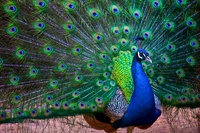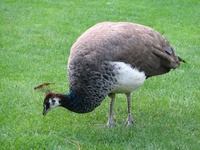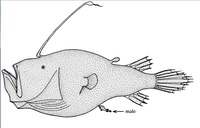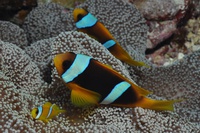Dimorphism: differences between males and females
The Redmap Team.
Right across the animal kingdom, males and females may differ in appearance - body size, colour, shape, armaments or ornaments. Here we take a closer look at what this means...
Difference between males and females of the same species is called sexual dimorphism. In some species, the DIFFERENCE between males and females is so great, that scientists have originally thought they were two separate species. In other species, the males and females are so SIMILAR – it is often difficult to tell which is the male and which is the female! Dimorphism between males and females can influence almost all aspects of an animal’s biology – including behaviour, ecology, physiology, demography and evolution.
There are several ways that males and females can differ in appearance: body size, colour (such as the peacock, see image), shape, armaments (weapons – structure used in combat with rivals, such as antlers/horns) and ornaments (a decorative structure/feature used to attract a mate). There are several reasons that this size difference exists, with main ones including:
- sexual selection (different traits evolve to attract a mate)
- natural selection (different traits evolve to benefit success/survival)
- niche-divergence theory (which is a complicated way of saying that each sex uses different space or resources to reduce competition)
Body size is one of the most important life history traits of an organism – with links to, and influence on, almost all areas of an organism’s ecology and evolution. Difference in body size between males and females is called sexual size dimorphism and is often one of the most obvious differences between males and females. Across the animal kingdom, females are often the larger sex – and with this typically comes a reproductive advantage (bigger females can usually have more offspring, or bigger/healthier offspring). In animals where males compete strongly for resources and mate gain, large size is clearly an advantage (so males are usually the larger sex).
Some extraordinary examples of size dimorphism exist in the marine environment:
· Blanket octopus (Tremoctopus violaceus) females reach up to 200cm in length, yet males are only 3cm long (That’s not a typo – two metre females versus three centimeter males!)
· Anglerfishes, such as triplewart seadevil (Cryptopsaras couesii ; see image) are known for their extreme size dimorphism…where males are essentially “parasites” on much larger females – becoming fused to her skin (permanently) – the female provides blood and nutrients and the male provides reproductive cells… Annnnd, I think we’ve all just re-defined what it means to have a clingy partner…
· Some clownfish exhibit size dimorphism with a twist! E.g. Amphiprion percula have male and female reproductive organs, and are capable of changing sex. The largest fish in the group becomes a female, the rest remain males (unless she dies or is displaced).
MORE READING:
- http://news.nationalgeographic.com.au/news/2003/02/0212_030212_walnutoctopus.html















